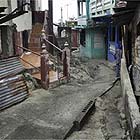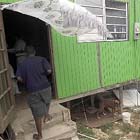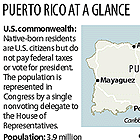|
 |
|
Esta página no está disponible en español. Orlando Sentinel Puerto Rico Aims To Empower People To Fight Poverty By Matthew Hay Brown | San Juan Bureau May 26, 2003 PHOTOS: RICARDO FIGUEROA FOR THE ORLANDO SENTINEL
Leisby Delgado, a single mother of two, wants real water service, something more reliable than the clandestinas, or secretlines that siphon water off the local system. Annie Nieves Rosado, an unemployed nurse, would like to see telephone lines strung between the makeshift homes. José Carrasquillo Rivera, an out-of-work cabinetmaker, talks about increased police vigilance -- more frequent visits, regular patrols, perhaps even a substation. All agree about paving the dirt roads. "When it rains, they become rivers," says Carmen González, a housewife who has lived here for nine years. "Cars get stuck. People have to take their shoes off to get out through the mud. They dry their feet when they get to the other side." In negotiating plans for their community, these neighbors are joining the most ambitious new antipoverty program Puerto Rico has seen in half a century, the first funded entirely by the island government -- and the only one to give the people the power to decide their own needs. This enclave of 60 families on the edge of San Juan is one of 686 neighborhoods in this U.S. commonwealth to win recognition as a Comunidad Especial, a Special Community eligible for a share of the $1 billion the government has earmarked to transform the pockets of lingering deprivation in which one-quarter of the population of 3.9 million still lives. "It's like an open wound," Gov. Sila Calderón says. "We have to heal it." The solution, Calderón says, is to let the communities choose the building projects and social services they want. In a process traditionally dominated by politicians, the new Office of Special Communities is giving residents unprecedented control -- a key, Calderón says, to finally breaking the cycle of dependency on government handouts. "This is a revolution of the spirit, a revolution of faith, a revolution of attitude," she says. "We cannot empower them. They have to empower themselves." José Figueroa Pesquera says it is the opportunity for which Toro Negro has been waiting. For 10 years, the community of 20 families in the mountain town of Ciales had petitioned officials for drinking water and a solution to the annual flooding that makes the road into their community impassable during the rainy season. Now the government has installed a water system and built four cement bridges to ford the stream that crisscrosses the road. "The eternal problem of this country is that agencies don't listen to the people," Figueroa says. "The difference now is the attention the government is giving us." Challenges elsewhere may require more than public works. Alto de Cuba, a barrio of 360 families in Vega Baja, needs water, electricity and telephone services. But its major problem, Ramón Vicente Martínez says, is that it is a major punto, a drug point that attracts addicts from throughout the island to any of more than 50 shooting galleries. At midday in the Callejón de le Muerte, or the Alley of Death, a dozen adults are "passing the note" -- high on heroin, traipsing down the street in slow motion or doubled over in place, eyelids half-closed, eyeballs rolled back. "There used to be more peace," says Martínez, the bodega owner who heads the neighborhood council. "Now the community is breaking. There are assaults, robberies, burglaries, killings. The youth have no compassion. The only law is the law of silence. To live here one must be very strong." Efforts once made strides In its scope, Special Communities approaches Operation Bootstrap, the program of rapid industrialization in the 1940s and '50s that for a time made Puerto Rico a worldwide showcase for development.
Government spending and tax breaks helped to attract manufacturing, mass migration to the mainland eased population pressures, and the delivery of property titles, the rapid expansion of public works and the introduction of literacy and other community-education programs lifted living standards for these who remained. But growth slowed with the oil crisis and the U.S. recession of the early 1970s. Free-trade pacts and rising wages have blunted the island's competitive advantages. Per-capita income has lagged at about one-third that of the United States. Unemployment is 12.5 percent; nearly half the population remains below the federal poverty line. "There's a difference between growth and development," says Miguel Soto Class, director of the Center for the New Economy, a nonpartisan think tank in San Juan. "Puerto Rico grew incredibly; it wasn't developed." Program model expands Calderón was the island's secretary of state when she first visited the Península de Cantera in the wake of Hurricane Hugo in 1989. The San Juan barrio was settled in the 1930s, when rural workers streamed into the capital in search of jobs, filled in the Martín Peña Canal with earth, debris and garbage and built tin-roofed wooden shacks. In the shadow of the Milla de Oro -- the Golden Mile of banks and financial corporations -- Calderón encountered an unplanned community of 4,000 families living on flood-prone land under the flight path into Luis Muñoz Marín International Airport. Water, electricity and telephone service, for those who had it, was unreliable; raw sewage discharged directly into the canal. Hugo had damaged or destroyed more than half the homes. Calderón pledged to work with local leaders; with her contacts in government and the private sector, she and the neighborhood council organized a nonprofit organization and a public corporation, outlined plans for improvements and secured tens of millions of dollars in public and private funds. During the past decade, the community has gained property titles, organized massive cleanups, introduced a recycling program and planted dozens of trees. Hundreds of new homes, water, storm and sewage systems, electricity, telephone and cable-television lines have been built or planned, along with parks, health clinics, community activities and job training. Francisco Fragosa, a fisherman who has lived in Cantera for more than 40 years, says he has seen the change. "There's more cleanliness, more pride in the community," he says. "Every day, the sense of value grows." As conditions have improved, local leaders say, unemployment and the school-dropout rate have fallen. "The big success of the project is the involvement of the community," says José "Chago" Santiago, president of the community council. "It is present at every level, in every decision. If we say no, it won't happen." Cantera became the model for the program that Calderón established when she became mayor of San Juan and that she expanded to the rest of the island as governor. In two years, Special Communities has identified eligible neighborhoods, sent organizers into the field and held workshops to develop local leadership. "The idea is that at long last communities can develop in their own hands," says Linda Colón, head of the program. "That's better democracy and better self-management." The first work began earlier this year. Over five years, $690 million is to be spent on the construction or rehabilitation of 20,000 housing units and $310 million on infrastructure improvements. 'I want to live peacefully' The residents of Alto de Cuba are seeking money to demolish the shooting galleries, install electricity and water lines, and build a methadone clinic, a police substation, a Police Athletic League clubhouse, a covered basketball court and a park with benches, swings and trees. María Milagros Rosario Urutia has lived in the community 68 of her 70 years. She still keeps the immaculate little home where she raised three children. Now there is a strip bar around the corner; the bars on her doors are a recent addition. "I don't want to leave, because this is my place," says. "But I am a prisoner. My neighbors have made my life unbearable. I want to live peacefully like before." From his well-kept house, the largest in Alto de Cuba, Martínez flies the flag of the Popular Democratic Party. His living room is dominated by a large photo of himself with Calderón. "None of the politicians had the courage to come up here," the lifelong resident says. "The governor came, asked for a walk and saw for herself. She has been the only governor who has helped us in this community." Critics claim it's publicity Support for the program has not been universal. In the news conferences, the drop-in visits and the weekly television show devoted to the program, critics see a costly public-relations campaign aimed at organizing grass-roots support for Calderón and the Popular Democrats. "It's just a repackaging of basically existing programs, put under the slogan of Special Communities," says Senate Minority Leader Kenneth McClintock of the rival New Progressive Party. "They're good at marketing. "The fact is, it's superficial help -- a publicity stunt that doesn't go to the roots of the problem. What these people really need is a job. What they really need is an education." Unemployment has risen from 8.9 percent under the New Progressive Party of Gov. Pedro Rosselló in 2000 to the current 12.5 percent. Efforts by the Calderón administration to lobby Congress for new tax breaks, authority to negotiate trade deals and exemption from a costly shipping law have come up short. "The state government should be involved in job and career creation," McClintock says. "We think they're really doing very little." Calderón dismisses the criticism as partisanship. Political opposition will not derail the program; the Legislature, controlled by the Popular Democrats, already has approved the $500 million grant from the Government Development Bank and the $500 million bond issue. But the public criticism may add pressure to show results by the gubernatorial and legislative elections next year. But the public criticism may add pressure to show results by next year's gubernatorial and legislative elections. Calderón announced last week that she will not seek a second term in office. "This program may be difficult to continue, because it is closely identified with her," says Francisco Martínez Aponte, head of the Economic Research Unit at the University of Puerto Rico. "If it gets momentum, and the communities are well organized, and organized not for political objectives, but for community, it's going to be very difficult to stop it." In what may be a sign of hope, more than a hundred neighborhoods not included among the original 686 have approached the Office of Special Communities asking to participate. "It's not glamorous to talk about poverty," Calderón says. "It's not a good topic for a politician or a mayor or a governor, because people don't want to look that way. It hurts. . . . But I don't care about that frankly, because you know it's there."
|

 CANOVANAS, Puerto Rico -- They meet out front of the Rosado house, the residents of Villa Hugo I, their ideas as varied as the wooden and concrete dwellings they have built into the hillside.
CANOVANAS, Puerto Rico -- They meet out front of the Rosado house, the residents of Villa Hugo I, their ideas as varied as the wooden and concrete dwellings they have built into the hillside.
 Per-capita income on the mostly rural island was $121 per year at the outset of Operation Bootstrap. Two of three dwellings had no electricity, three of four had no running water, six of seven had no sewer service. Malnutrition was widespread; life expectancy was 46 years.
Per-capita income on the mostly rural island was $121 per year at the outset of Operation Bootstrap. Two of three dwellings had no electricity, three of four had no running water, six of seven had no sewer service. Malnutrition was widespread; life expectancy was 46 years.